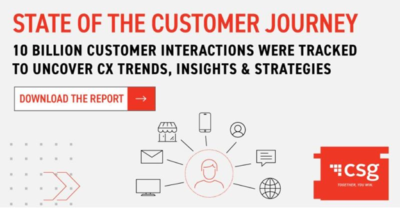Think about how much the world of customer experience (CX) changed from a year ago. What did you learn about your customers since early 2021? What can your business do to digitally engage them that seemed impossible then? And what were the CX trends and consumer behaviors you saw changing over time?
2022 will be just as transformative—if not more. Still, CX leaders have to look ahead and anticipate what’s going to win, and keep, customers from their competitors.
At CSG, we’re looking ahead, too. We asked our leaders in customer engagement to predict what 2022 has in store for CX. Here’s what they had to say.
1. Leveraging Micro-Moments for Loyalty Will Separate CX Leaders from Laggards
Liz Bauer, Chief Marketing & Customer Officer
You know an extraordinary customer experience when you’ve had one. On a recent trip, I was able to check into my hotel room using my mobile phone and skip the line at the front desk. Convenient, right? But it’s what the hotel did after my check-in that I’ll be talking about for a long time (including here, it turns out).
The hotel sent me a message telling me what time the coffee kiosk opens each morning, and then another message with the fitness center hours. The brand knew from my previous stays that those are the two amenities I always use. And they anticipated the “settling in” moment when I’d be seeking that information. It’s a small gesture, but the intentionality it conveyed was enormous.
The brands that understand how to use micro-moments—when consumers reach for their mobile device to see or do something—to solidify loyalty will expand their lead in CX over those that don’t. After all, I can’t be the only consumer whose expectations rise after receiving such intentional treatment in the moment.
2. Companies Will Further Shift Their North Star from Cutting Costs to Improving Customer Experience
Alfred Binford, President, Customer Engagement Solutions
Companies’ objectives for customer engagement solutions and technology investments will further shift from cost reduction to elevating the customer experience (CX). Where the ROI on digital messaging or ecommerce solutions was once primarily based on call deflection from customer contact centers, increasingly, enterprises want to go beyond call deflection and improve the real-time orchestration of customer journeys across a multiplicity of channels.
In 2022, “growing the business” will be a top priority for over 60 percent of customer service and support leaders, according to a recent Gartner survey. We at CSG predict that this growth emphasis for CX will drive companies to raise their brand preference and customer retention in various ways.
Brands will get better at identifying which customers are most likely to churn or defect, and then systematically determine the “best next action” for those customers—at scale with digital messages or hyper-targeted offers to retain them. Many businesses can already access much of the data required to create “always-on” and proactive CX programs. Now, they need assistance to improve how they turn all that data into insights, those insights into action, and those actions into the outcomes they seek.
3. These 4 Industries Will Transform How They Engage Customers
Eric Carrasquilla, SVP, Digital Engagement Solutions
“Good enough CX” is no longer good enough (as I mentioned in this post), and part of what’s driving that is an elite few brands raising the CX bar high for every company, regardless of industry. Some industries face a greater risk of disruption than others, and you can expect them to make bolder moves to differentiate their experiences:
- Retail—Instead of competing with eCommerce giants on catalog depth or price, retailers will continue innovating their in-store shopping experiences. This includes more intuitive touchpoints relating to curbside pickup, notifications and loyalty programs.
- Financial Services—Banks will vastly improve key journeys by understanding their customers’ preferences. Take fraud alerts: knowing that Jane Doe doesn’t answer unexpected phone calls, the bank sends her alerts via text instead.
- Healthcare—Because they can be fraught with friction, patient journeys are ripe for improvement (and especially important to address during the ongoing pandemic). Watch for more providers to streamline patient intake processes or prescription refills using digital solutions.
- Telecom—Reinforcing customer loyalty is the B2C ballgame for telcos. Look for them to bundle more services to that end, like TalkTalk’s Netflix package in the U.K, and leverage them in highly personalized offers.
4. 2022 Will Be the Year of Customer Data Centricity
Mark Smith, VP, Digital Engagement Solutions
What do you think of when you hear the term “customer centricity?” For many business leaders, it’s enabling the customer to do what they want, when they want and how they want. That’s been a key principle for providing excellent experiences.
But more and more, we’re seeing businesses broaden their idea of customer centricity to include data and trust. Eighty-three percent of global business leaders say consumers are demanding greater control over their data. So while data privacy regulations have pushed businesses to adopt more transparent consumer data practices, many of them are also embracing those changes as a response to what customers really want.
To build more trustworthy brands in 2022, we’ll see businesses offer more data preference management and control, including giving customers more input in how their data is used. In other words, they’ll center their data handling around the customer, much like they do with the personalized experiences they’re crafting with that data.
5. The Time Has Come for Contextual Orchestrated Journeys
Yogen Patel, VP Product Management, Digital Engagement Solutions
Companies have always wanted to provide timely, context-driven, personalized engagement—that is, the ability to drive the best next action for customers, stepping them through to an upsell, successful onboarding or another desired outcome. Many organizations will finally gain this ability in 2022 due to three factors:
- Consumers expect it now more than ever—As consumers use more digital channels to communicate with brands, and at any time, their journeys become less linear and more complex. This dials up the urgency for orchestrated digital journeys so customers can have the best, most personalized experiences.
- The data is there—Thanks to their digital transformation investments, companies have the data needed to extract insights to execute purposeful and intelligent customer journeys. Additionally, there are many more data-capture hooks for interaction data and behavioral signals (profiles, events, actions, triggers and more).
- The tools are (finally) there—Companies can now leverage cloud-based solutions, from real-time analytics to journey management, that can help connect and process vast amounts of data, extract insights and drive actions and tailored experiences—all while sitting alongside their existing systems. This final piece will be the catalyst for reengineered customer experiences.
6. FSM Solutions Will Need No-Code/Low-Code or They’ll Be No-Go
Jim Hare, VP & GM, Global Field Service Management
As consumers, we expect to be able accomplish more and more tasks ourselves, like solving a product issue by chatting with a virtual assistant. That self-service expectation carries over to how we get things done in business. So it’s no wonder we’re seeing companies adopt more no-code/low-code solutions, particularly those using a journey orchestration layer.
Companies are seeing the benefits of journey orchestration to streamline adding or changing features in field service management (FSM) software they’re using. For example, when COVID-19 hit, many field service operations added health and safety checklists to their technicians’ mobile devices. Some companies might have waited weeks or months for IT or a vendor to add that function, while others used a low-code architecture to launch it in a few hours.
We’ll see more companies demand that all their FSM solutions carry an orchestration layer that lets their non-IT personnel manage integrations and customizations. Companies need to adapt quickly, and low-code and orchestration layers help their solutions keep pace.
How Prepared Are You for 2022?
There’s more where this came from. Our experts share insights in customer engagement and other topics every month in the CSG Perspectives e-newsletter—you can sign up for it at this link.
And as you’re thinking about what 2022 will bring, make sure you’re caught up on the CX trends by reading our State of the Customer Journey Report.
Knowing what it will take to win (and keep) customers is one thing; executing on that knowledge is quite another. Fortunately, there are better digital engagement solutions than ever to help brands wow customers. If your business is struggling to engage them in real time throughout their journeys, 2022 is the year for getting it right. Let’s make it happen.







